#macleays spectre
Explore tagged Tumblr posts
Text
guess who has a pet now :)

#gothghostiie#ghostiie has a pet#!!!#they're so small#insect#giant prickly stick insect#macleays spectre#its literally called Australian ghost scare in German#ghostiie rambles
2 notes
·
View notes
Text
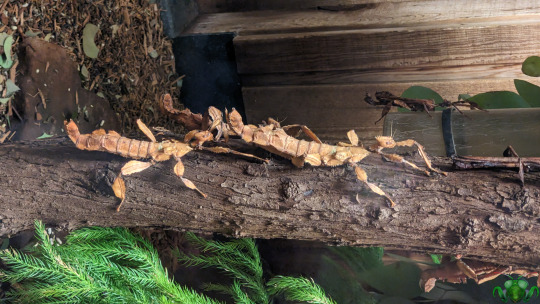

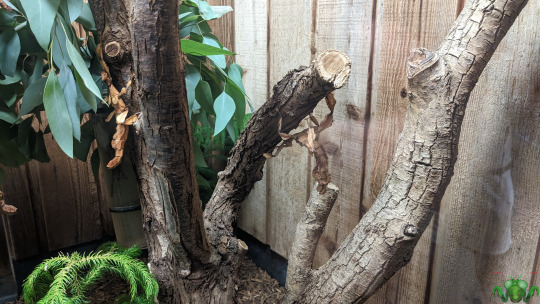
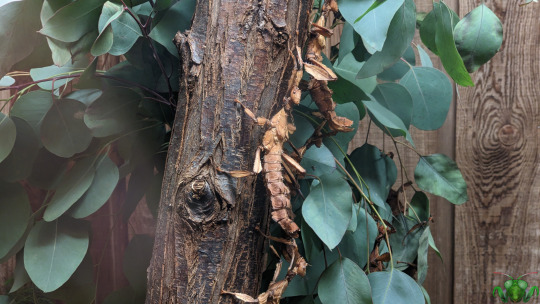
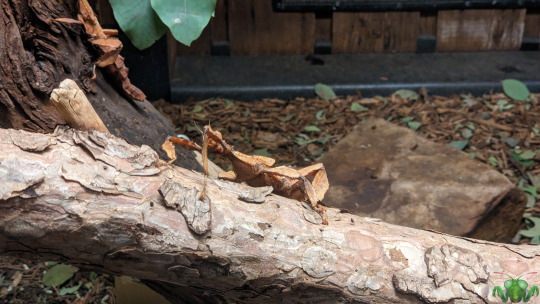
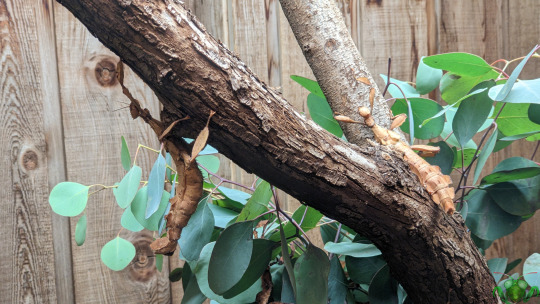



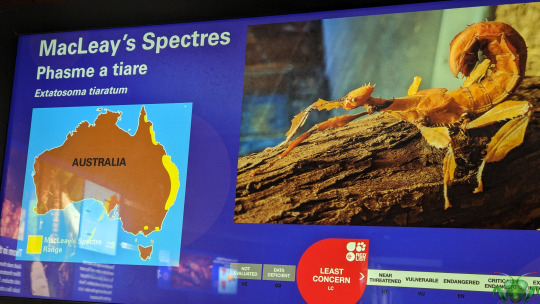
Spiny Leaf Insect - Extatosoma tiaratum
It's been many years since I've laid my eyes on one of these magnificent creatures, and even longer since my days at U of T where I held one in my hand. As such, it was gratifying to see so many individuals on display at the Toronto Zoo and to soak in all their details and movements (mostly wobbles and slow, methodical steps) while observing them. With many female individuals, and a few different instars among them, I should have taken a video, but there was lots of excited screaming in the background from children happy to see the otters and reptiles. As much as I love animals, this blog is all about the insects, and so today we have pictures of these Giant Prickly Stick Insects. Today, they are known by many names such as Australian Walking Sticks, Spiny Leaf Insects, Macleay’s Spectres (named for British entomologist William Macleay and referencing their order Phasmatodea, whose name is derived from apparitions or more commonly, ghosts) or E. tiaratum. You can call them many names, just don't call them "Leaf Insects" as those are a different branch of Phasmid, of the family Phylliidae. Amazing as that family is are, these large armored insects also have a certain special quality to them. Maybe it's just how large and unusual they are compared to our fauna, but I certainly think that they're eye-catching when they can actually be found and observed. In the wild, finding them could be more difficult since their mottled, spiked, dried-in-appearance leafy armor is meant to hide them from their predators.
These peaceful, plant-eating giants need every advantage they can secure since they aren't aggressive and are burdened with slow movement due to their armor. In most cases, if anything gets close, their "scorpion" posture combined with a mild chemical defense and their sharp spines may be just enough. But what if you're a thinner, more agile male? If you've been observant, there is one such darker individual in the background of Picture 1! They're quite different in appearance from females, being much smaller and they are also quite rare! Moreover, a mild reliance on using parthenogenesis to reproduce and lay eggs, they can become even rarer! The thin male has functioning wings and can use them when in danger by either flying away or flashing them to a predator, startling them. Naturally, wings also allow for a wider dispersal and an expansion to the search for fertile females. In an environment within captivity, the presence of a male may be likely to discourage parthenogenesis and in fertilized eggs that will hatch earlier after females drop them to the soil floor. There were no eggs to be found, so if you plan to visit and search for them, look for brown and white, seed-like objects fitted with a capsule-like projection (capitulum). They are likely to be removed and stored, as the eggs of E. tiaratum are reported to need cooler conditions to successfully hatch. Their terrarium may simulate a warm, tropical environment too well in that case. In the wild, Ants fulfill this condition, bringing the "seeds" underground into their cooler subterranean food stockpile.
These insects are exhibited in the Toronto Zoo, so I’ve marked them with the Mantis icon. Pictures were taken August 27, 2023 at the Toronto Zoo with a Google Pixel 4. Please go and visit the animals (insects very much included).
#jonny’s insect catalogue#ontario insect#stick insect#spiny leaf insect#macleay's spectre#phasmatodea#phasmid#insect#toronto#toronto zoo#august2023#2023#nature#entomology#invertebrates#arthropods#animals#photography
17 notes
·
View notes
Text
see the fandom has this thing where the hermits are different species and when they’re part animal/mob they’re a hybrid but nobody talks about the even funnier canon lore that they’re all the exact same species. Their species is hermit.
[long post - lots of worldbuilding and speculative biology below]
Jevin looks like a slime, Doc looks like that, most of them look human, but in actuality they’re all just hermits. The only information we have about this is that hermits are shorter than the average player, some references to hobbits, some references to hermits being hardworking, the fact that gem isn’t a hermit and had to wear antlers to pretend to be one, and that’s it.
I love biology and worldbuilding and this is fascinating to me. When you take into account previous seasons and events and throw-away lines this gets even more insane. Grian and Hypno are acknowledged to not have mouths (and even more hermits don’t have them on their skin). Mumbo turned into a potato. Cleo had snake hair at one point. There are a million other weird things I’m forgetting. You could handwave some of this with an explanation like “hermits are shapeshifters” or “hermits are gods” and that is a very valid and fun take but I think it is SO much funnier if these are just normal things that happen in the hermit species, which aren’t fantastical at all and are adaptations with elaborate mechanics and explanations.
Perhaps hermits, similar to bugs, regularly shed their skin (or a process similar to it) and change their appearance. Some insects change colours/appearance due to their environment rather than genetics, ie macleays spectre stick insects can turn lichen colours when raised around lichen. Maybe the hermits shed their skins on a regular basis, including during their adult life, and this allows them to better match their environment- causing physical changes related to what they have been exposed to. This causes potato Mumbo and medusa Cleo and DM Tango and any other example of a specific skin change. For more constant differences in appearance - maybe life cycles could be considered?

this may be the weirdest thing I’ve ever made. For those that don’t know, “n” is the number of chromosomes, where n is the haploid number, so 2n is diploid. Diploid cells are necessary for sexual reproduction. Of course, a lot of these life cycles are centered around reproduction, as is the nature of a life cycle, but in reality the hermits are in no rush and are happy to stay at whatever point of the life cycle they’re at, this is just an outline of the species’ mechanics.
I mean, most of this diagram is conjecture… but I think it is interesting to consider! Jevin especially reminded me a lot of slime mould life cycles so this is heavily inspired off that, but also inspired by bug life cycles as well.
If you want to get even more indepth we can consider the gender roles of hermit society (remember that clip where Grian implied builders were housewives and redstoners were breadwinning husbands?). Perhaps we can get meta and consider respawn an aspect of being a hermit as well - are they able to regenerate after death? What is Cleo’s place in all this, being undead? Is arm thickness, where your arm can either be 3px or 4px wide, an example of sexual dimorphism?
but. well. tldr: the hermits being one species is a very fun idea we should be doing more with, i think
#this started out as haha funny the hermits are one species and ended with me making scientific diagrams#decided to call those stages imago. like insects. best fit i could find for what i wanted#please ask me about my thoughts on courtship and evolution and early life stages and respawn and anything else please god#locus fandom time#i should have a tag for my insane antics#locus worldbuilding time#hermitcraft#long post#hermitblr#speculative biology#the ideas here are heavily biased towards slime moulds and insects because. well. autism.
304 notes
·
View notes
Note
fun facts about australia: we have various species of stick insect but my favourite species is the giant prickly stick insect!! they’re also called spiny leaf insect, macleay’s spectre or the australian walking stick!! they live pretty much entirely of eucalyptus but ive heard they can also eat bramble as well?? if they lose a leg when they’re young they can drop it and regrow it, but not when they’re adults. the females are bigger than the male and look more like bulky dead leaves than sticks. if there are no males the female can produce eggs, but they will only be female as they are clones of their mother. so they’re like half asexual. its called parthenogenesis!!! these bugs are entirely harmless (even though the females do sort of resemble a scorpion) and you can keep them as a pet <3

footage of me running from australia
7 notes
·
View notes
Photo
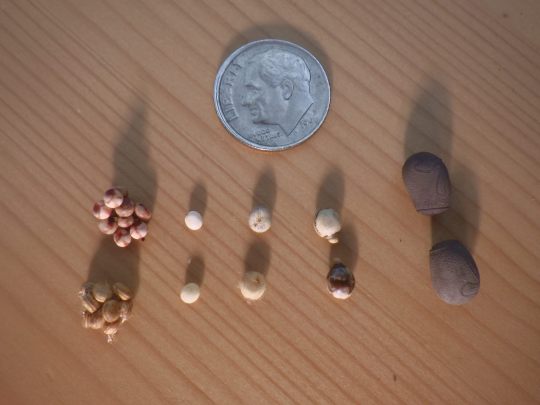
Insect eggs from left to right: clusters of Atlas moth eggs; Saturniid moth eggs; Madagascan comet moth eggs; Extatosoma tiaratum eggs (Macleay’s Spectre Stick Insect); Heteropteryx dilatata eggs (Jungle Nymph Stick Insect).
#egg#eggs#insect#insects#insect egg#insect eggs#moth#moths#atlas moth#atlas moths#moth egg#moth eggs#saturniid#saturniids#madagascan comet moth#madagascan comet moths#stick insect#stick insects#stick insect egg#stick insect eggs#macleay's spectre stick insect#extatosoma#extatosoma tiaratum#jungle nymph stick insect#heteropteryx#heteropteryx dilata#nature
2 notes
·
View notes
Text

Macleay's Spectre
Extatosoma tiaratum
Source: Here
163 notes
·
View notes
Video
youtube
10 notes
·
View notes
Note
I like your stick insects! I was surprised to see someone else raising phasmids, though I guess we've got to keep them on the down-low in the US so they're not a very common sight on tumblr. I've got a few walking leaves, thorny devils are interesting but I'm a little afraid of the spurs, I'll admit. I think I'd start with a Macleay's spectre if I was going to raise stick insects, I think the ones that look like lichens are neat. Do you raise other phasmids, or just the devils?
I keep the devils, Macleay’s spectres, budwings (Phaenopharos khaoyiensis- nice species, they’re large “typical stick”- types sticks with teeny, bright red wings) and native Diapheromera femorata. I’ve tried and failed to raise eggs Diapherodes gigantea, Phyllium siccifolium, Sunguya inexpextata and Heteropteryx dilatata in the past, mostly because few or none of them hatched to begin with.
The spectres are nice (right now I have 2 adult females, 2 males, a bunch of tiny nymphs and wayyyy more eggs than I know what to do with), but if you live in a part of the country with a cold climate they can be tough to feed. They only eat rosids like blackberry and oak, they won’t eat any of the common evergreen plants in my area. So I have a few plastic bags full of oak leaves in my freezer to keep em fed through the winter months.
The lichen forms are very pretty, but I have yet to get any lichens or green forms out of my broods, only varying shades of reddish brown and tan. The color differences are environmental, not genetic. Different temperatures, foodplants and humidity levels (as well as adding lichen to the enclosure) seems to be what helps nymphs achieve prettier colors.
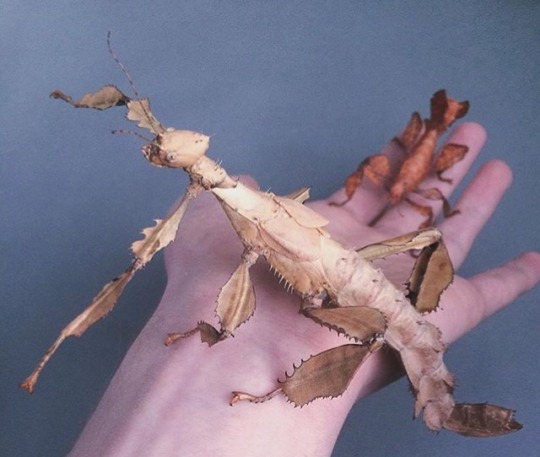
A couple of my spectres from last year, my current specimens aren’t this nice.

Not my insect, but a beautiful Phyllium giganteum I got to hold awhile back. P. giganteum is my dream species, sadly they’re a little harder to obtain and not the easiest species to keep alive.

Don’t fear the devils. I suspect they get their bad reputation from people who think you should pick up insects by grabbing them with no forethought. Treat them with respect and they’ll return the favor.
68 notes
·
View notes
Photo
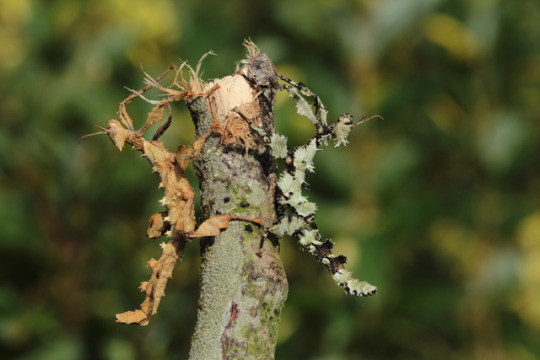
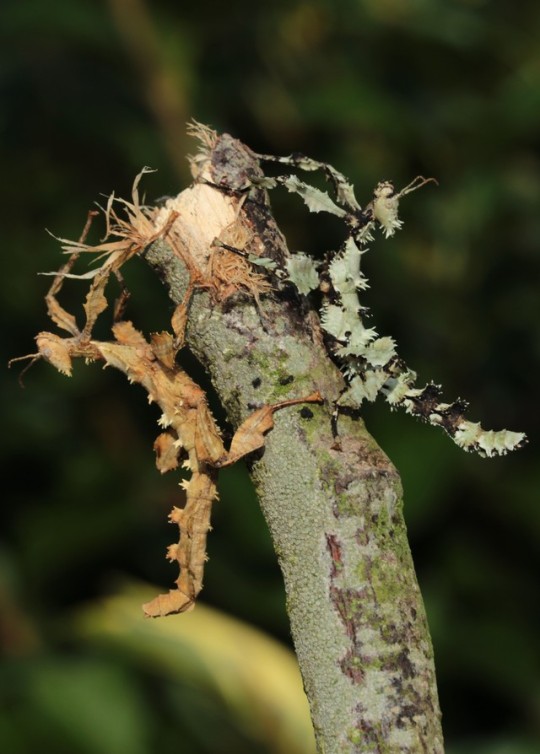


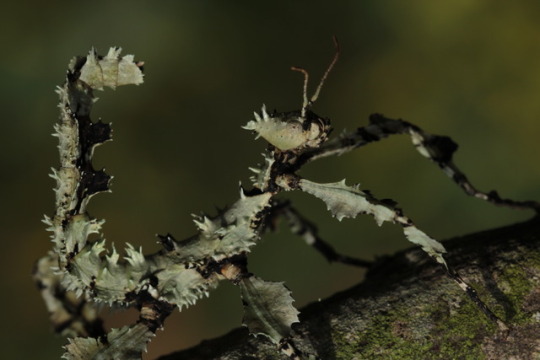
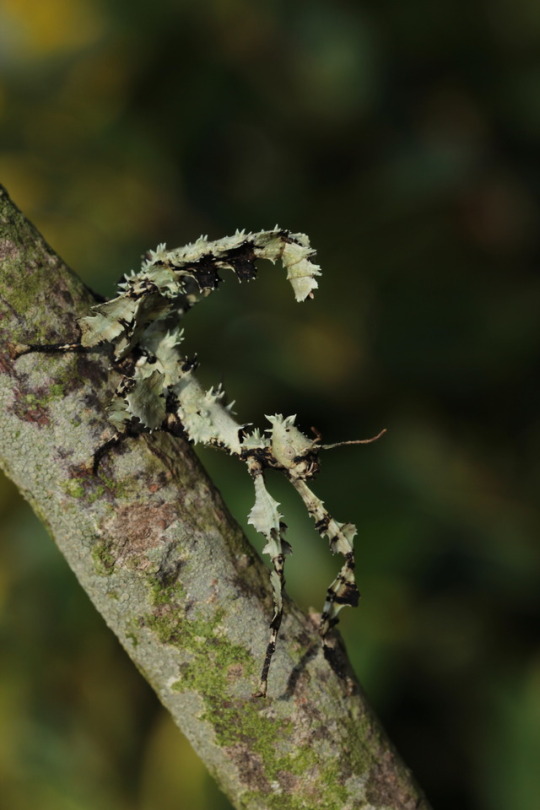
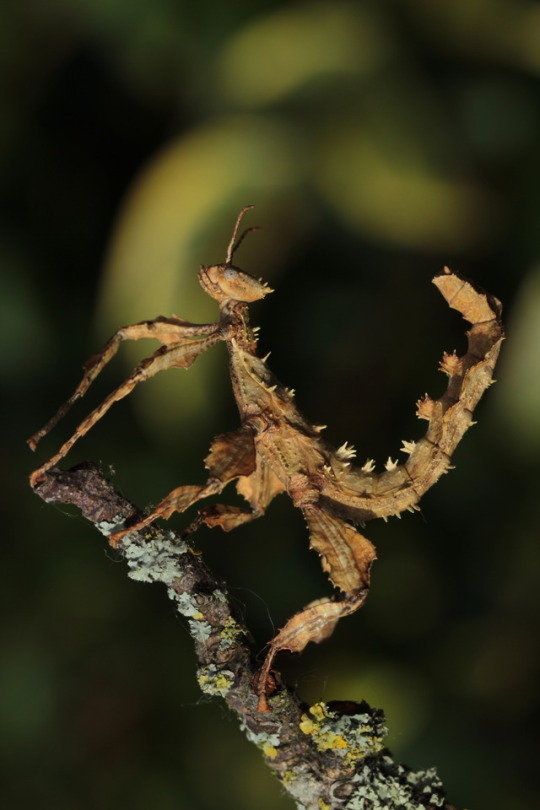
This is the pure "Innisfail" locality which is often labelled as the "Lichen" Macleay's spectre. The lichen form is not garunteed though and only seems to happen if nymphs are surrounded by lichens whilst growing. The lichen colour morph potentially occurs in other localities. Even with the stimulus of lichen present the colour morph still seems rare, only 2 show it out of 40.
#Extatosoma tiaratum#Innisfail#australia#australian#giant#prickly#lichen#colour#morph#camoflauge#for#spiny#stick insect#captive bred#exotic pet
221 notes
·
View notes
Photo
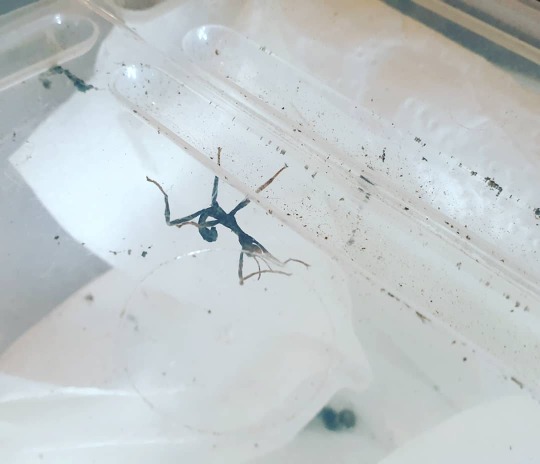
Extatosoma tiaratum (Macleay's spectre) first scout out of the ova. Hopefully the rest follow pretty soon . . https://www.patreon.com/predorpreyonline . . #tarantula #tarantulasofinstagram #invertsofinstagram #invert #picoftheday #instagood #tarantulas #tarantulalover #instataranula #tarantulasofinstagram #spiderporn #spidersofinstagram #eightleggedfreaks #tarantulas_worldwide #tarantulasofig #tarantulasoftheworld #predatororpreyonline #tarantuladaily #fang_gang #invert #arachnidsofinstagram #arthropods #spidersoftheworld #tarantulalove #TarantulasLair #instafollow #instawow #wildnature #wildlifeofinstagram #instacool #unbeleiveable #wow (at Swansea, United Kingdom) https://www.instagram.com/p/B5Z9JxyhS4L/?igshid=ixf7koptlm5b
#tarantula#tarantulasofinstagram#invertsofinstagram#invert#picoftheday#instagood#tarantulas#tarantulalover#instataranula#spiderporn#spidersofinstagram#eightleggedfreaks#tarantulas_worldwide#tarantulasofig#tarantulasoftheworld#predatororpreyonline#tarantuladaily#fang_gang#arachnidsofinstagram#arthropods#spidersoftheworld#tarantulalove#tarantulaslair#instafollow#instawow#wildnature#wildlifeofinstagram#instacool#unbeleiveable#wow
0 notes
Photo

Spiny Leaf Insect - Extatosoma tiaratum
Having one of these armored insects crawling around on the palm of your hand is a really special experience. Perhaps crawling isn’t the right word, wobbling or swaying is more accurate. As I mentioned in the previous post on this insect, this spiny insect wobbles to mimic a leaf blowing in the wind. This tactic is much more effective while hanging onto a tree branch. Fortunately, we didn’t have any plans to eat this insect. It also was in an arched position as well, trying to keep us away by resembling a scorpion. Using insects like this one, the Hissing Cockroaches and an Annam Walking Stick was a way to introduce first year students to the diversity of insects and showcase how some of the more exotic insects (this one being native to Australia) and how they adapted to the environment. While I’m biased, I think the Giraffe Weevil would be another good insect to showcase, but it lives on the island of Madagascar, so good luck finding one and bringing it in.
The females of this specie are much larger than the males and have sharper spines and armor to protect them. As a trade off however, this makes them heavy, slowing down their movement (no problem) but rendering their already small wings useless (problem?). Males on the other hand get to keep their wings and can use them to fly or scare predators by flashing them. Being able to fly also makes finding mates easier. They receive these wings during their final molt, similar to most adult insects like Cicadas, and just like Cicadas, they like to hang off of branches and greenery while they shed. When the female undergoes her final molt, she retains the curled abdomen and a much more armored shell. Hmmm...it’s possible this Stick Insect was a female and thus kept it’s tail curled for that reason, but I’m not sure this one was done molting; other images of female stick insects show me that they can grow even larger. Fondly enough, they start off as tiny twigs that mimic Ants so predators leave them alone before taking on their arborous look. They’re also remarkably fast while they’re young, slowing down as they gain more armor.
As a final note, if Spiny Leaf Insects can’t find each other at all in the wild, the female can actually lay eggs that are effectively clones of herself. Certainly a useful strategy to help dispersal. I wonder how much influence the phenotype (gene expression through the influence of the environment) has in a situation like this, I mean, for things like color, shape, textures, etc. Stick Insects survive the best when they can all hide among the trees, but the environment has a strong influence over this. Check out some of the different color morphs if you can.
Since these insects technically belong to U of T, I’ve labelled this image with the mantis logo. Pictures were taken on September 19, 2012 within the labs of the University of Toronto with a Samsung Galaxy Glide
#jonny’s insect catalogue#stick insect#spiny leaf insect#macleay's spectre#phasmatodea#phasmid#insect#ontario insect#toronto#september2012#2012#entomology#nature#invertebrates#arthropods#photography#animals
6 notes
·
View notes
Video
Just casually having a brawl on my hand 🙄 #macleaysspectre #macleays #spectre #bugfight
0 notes
Text
On the first day in town, we actually didn’t go to EGLX yet but rather went for a day at the zoo. Normally, whenever we go to zoos, its pretty much a quick max 4 hour experience but Drew had mentioned that he was set for a full day there and other than a short lunch break, Toronto Zoo did have a lot to see and we stayed for about 7 hours. The highlight for Toronto Zoo which ends this weekend is saying goodbye to the Giant Pandas, who happen to be the first pandas born in Canada.
Toronto Zoo is pretty huge. It covers a lot of different continents. Due it still being in the winter schedule, it had a lot of empty spots so some areas like Africa was just a walk through the place and then checking out the pavilion. I think that is what sets it apart is that there are a few pavilions to go through for the more exotic animals and it gives it a lot more space to check out some cool birds and more.
Since this was a huge day and I have like 800 pictures or something, I’m going to trim it down to pictures that turned out well or animals that I found were pretty unique to this location.
Giant Panda Cubs
Red Panda
Tree Kangaroos
MacLeay’s Spectres
Polar Bears
Otters
Gorilla
Pygmy Hippopotamus
Red River Hog
Jaguar
African Lions
Komodo Dragon
Greater One Horned Rhinoceros
And here you go! Not all of them are really that rare but its always a challenge to get pictures of animals because of how far away they are. A lot of really cool ones here in all the different areas plus a lot of them are various levels of endangered which really makes it worth it to see them protected. There was a ton more than what I have here from meerkats to sloths and all kinds of monkeys and a lot of fishes and frogs and snakes and other reptiles and insects. I could go on and on.
Toronto Zoo is really worth it to just see what they have. Not a lot of zoos have such a huge terrain with indoor pavilions and outside areas. It would be nice one year to visit when its the summer to see how its set up when a lot of the warm climate animals are back.
Plus, luck was really on our side for the zoo. A lot of times we would be right on time for feeding times or speaking by the carers of a certain animal. Sometimes, we’d double back and the animal would have woken up from their nap and started moving around. It was a really great time!
Toronto 2018: Toronto Zoo On the first day in town, we actually didn't go to EGLX yet but rather went for a day at the zoo.
0 notes
Photo

Meet the Jungle Nymph and Macleay's Spectre
Hurry and watch this video on http://videosgoviral.com/meet-the-jungle-nymph-and-macleays-spectre/39006/
0 notes
Video
tumblr
A friend took this video. This is our Macleay's spectre ( Extatosoma tiaratum) Sheikki.
0 notes
